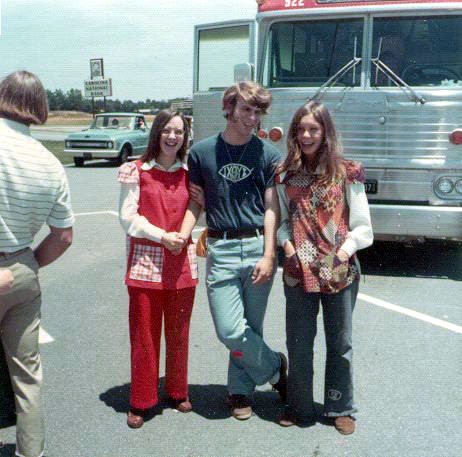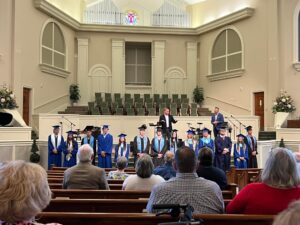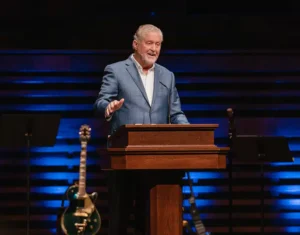
EDITORS’ NOTE: The following three stories focusing on an outbreak of revival in Easley, S.C., during the early 1970s are part of a monthly Baptist Press series to explore and describe how individuals, churches, associations and conventions exhibit a passion for Christ and His Kingdom.
EASLEY, S.C. (BP)–Although 30 years have passed since its peak, those who were involved in a revival that spread across a wide region are still celebrating its impact.
According to those involved, a revival in Easley, S.C., began soon after a Christian coffeehouse opened in 1970. The outreach was organized by Southern Baptist layman Terry Ballenger and his wife, Greer.
“It was some golden days for my wife and me,” said Ballenger, communications manager at Blue Ridge Electric Cooperative near Easley. “We look back at what happened with a sense of awe. Jesus just showed up.”
Louisiana pastor Larry Thompson, one of the first converts, said the move spread to Easley High School and led to numerous area revival services.
From there, he said it spread to nearby Anderson and North Greenville colleges (now universities) and eventually to areas of Georgia and North Carolina.
The excitement also led Ballenger to charter two buses to take approximately 80 students to “Explo ’72” in Dallas, an evangelistic-oriented event organized by Campus Crusade for Christ.
No one tracked the number of conversions. Still, participants say because of the revival several dozen people are in fulltime Christian work today. Hundreds more are faithful church members.
Each Christmas season, 15 to 30 participants gather in Easley to reminisce about the revival and celebrate what God has done.
Dale Ellenburg, vice president for academics at Mid-America Baptist Theological Seminary near Memphis, Tenn., likens what happened to a late 1850s revival that originated with a prayer meeting called by businessman Jeremiah Lanphier.
“It was an unexplained, spontaneous moving of the Holy Spirit that has put people in ministry throughout the past 30 years -– dozens of them,” Ellenburg said. “It was amazing.”
“I’ve never gotten over it,” said Thompson, pastor of First Baptist Church in Westlake, La. “I’ve never gotten over the Bible and seeing people saved. I get frustrated when it doesn’t happen. I have an intense desire to see revival come again.”
Ballenger, who found a closer walk with Christ through Campus Crusade while in college, organized a Sunday evening home Bible study for Easley teens that went by the name “Christians Unanimous.”
The Bible studies circulated to various participants’ homes before later settling in a hut in a city park that had once been home to a Boy Scout troop.
It became known as the coffeehouse because they brewed coffee in the beginning. Ironically, when no one drank any, they stopped serving it after six months, Ballenger said.
Thompson recalled how young people -– many dressed in 1970s “hippie” style clothing -– painted the hut’s walls black and added Scripture verses in fluorescent colors. The verses would glow when the youth turned on a black neon light.
The primitive furniture and fireplace contributed to a casual atmosphere that drew crowds of high school and college students, Thompson said.
The coffeehouse was open Thursday and Friday nights and Sunday evenings after church.
After fellowship, Ballenger would call for quiet and teens would be expected to read or study the Bible. This would be followed by prayer, testimonies and music, Thompson said. “Then we would hit whatever restaurant would let us scrounge there,” he joked.
“We were always free to let the Holy Spirit lead,” Thompson said. “Sometimes on Sunday there would be a guest speaker, but more often than not there was a teen doing preaching or teaching.”
These early sparks quickly spread to Easley High School, where morning Bible clubs formed. In addition to drawing dozens of students, the clubs led to revival meetings at the high school and other locations.
While Christian speakers gave anti-drug or other positive messages in school assemblies, they would invite students to return to evening revival meetings, Thompson said.
“A bunch of us were asked to do youth revivals,” Thompson said. “I was 18 years old, in blue jeans, preaching at First Baptist churches across the state and people were getting saved constantly.
“It wasn’t just at church and youth rallies. Many of us led people to Christ in classes, at restaurants and at football games. It was natural for me to get a knock on the door at 2 or 3 in the morning and someone who had been a Christian for one or two weeks would say, ‘Joe needs to get saved. Can you tell him how to do that?’”
Although known as the leader, Ballenger said he wasn’t that spiritually mature when the revival began.
When standing-room-only crowds materialized a year after the coffeehouse opened, Ballenger recognized God was doing something special.
“I helped as I could but I had to grow myself,” Ballenger said. “That ministry encouraged me and helped me get deeper in my faith. I got deeper into the Word and understanding the Old Testament and how it’s important to the New Testament.
“All those things brought me to a better understanding of how to live as a Christian. The discipline of a daily quiet time is something I practice to this day.”
Despite the excitement, the revival ebbed in the latter half of the 1970s, something Ellenburg called natural.
“Revivals and great awakenings don’t last,” Ellenburg said. “They’re not supposed to; you can’t stay in perpetual revival. God graciously sends them for times of refreshing.”
Measured against societal changes of the past 35 years, though, the question is whether the coffeehouse is a viable model for other communities that would like to see a youth revival.
While Ballenger thinks it is possible, he said it won’t be simple to replicate, particularly because of life’s hectic pace.
For example, he mentioned how Easley used to come to a standstill because almost everyone went to high school football games on Friday nights; today, however, that isn’t as common because of other distractions, such as video games, the Internet, cable TV and mega-malls.
Still, Ballenger pointed out that young people still hunger for spiritual growth and answers to life’s perplexing problems.
Whether a coffeehouse or another venue or strategy, Ballenger said, “It would be up to us as believers, especially those of us who want to see young people get off on the right foot, to figure out what that is.”
–30–
















